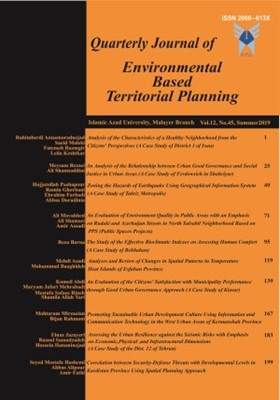The Study of the Effective Bioclimatic Indexes on Assessing Human Comfort (A Case Study of Behbahan)
Subject Areas :
Reza Borna
1

1 - Associate Professor, Department of Geography, Islamic Azad University, Science & Research Branch, Tehran, Iran
Received: 2017-03-13
Accepted : 2017-09-17
Published : 2019-08-23
Keywords:
Stress,
bioclimatic comfort,
Behbahan,
Beiker,
Terjung,
Abstract :
Recognition of natural potentials as the basis of human activities forms the foundation of the environmental planning and arrangement. In this regard the climate characteristics and its factors have an essential role in the spatial dispersion and forming environmental activities of human societies, as today's studies and surveys on human being are the bases of urban, developmental, residential, architecture, tourism planning. In this study, man’s comfort or discomfort in Behbahan has been studied based on the existing living climate models and bioclimatic indexes of Beiker, Terjong, stress and TCI have all been studied using the statistical data during 20 years (1994 - 2013), and is the best time for doing the environmental and tourism activities in this city were determined. The results showed that wind chill index has not been based on the climatic activities. The other bioclimatic indexes which were used in the study were the ability of showing comfortable and discomfortable periods of Behbahan which in spite of few differences, they show the similar pictures of the city’s climate comfort .The study showed that Behbahan with bioclimatic variety during the year has both warm and very cool weather. There is not good comfort in the last month of spring and during summer in this city. When autumn finishes and the weather becomes cool (November and December) or when later it starts to become warm (March), Behbahan has a more comfortable condition for people. Totally autumn and winter are suitable for environmental activities and touring in Behbahan.
References:
بذرپاش، ر.، ملکی، ح.، حسینی، ع. 1387. بررسی آسایش حرارتی در فضای آزاد جهت اکوتوریسم در شهرستان بابلسر، فصلنامه تحقیقات جغرافیایی، 90: 108-93.
پاینده، ن.، زکی، غ. 1384. محاسبه دمای مؤثر استاندارد با طراحی نرم افزار سلامت، مطالعه موردی: محاسبه دمای مؤثر 130 ایستگاه سینوپتیکی کشور، مجله پژوهشهای جغرافیایی، 57: 92-73 .
ترکاشوند،م. 1395. آشکارسازی جزایر حرارتی شهر اراک مبنی بر تحلیلهای خود همبستگی فضایی. مجله آمایش محیط، 35: 148-123.
ذولفقاری، ح. 1386. تعیین تقویم زمانی مناسب برای گردش در تبریز با استفاده از شاخصهای دمای معادل فیزیولوژی(PET) متوسط نظر سنجی پیشبینی شده (PMV)، مجله پژوهشهای جغرافیایی، 62: 141- 129.
ساری صراف، ب.، جلالی، ط. 1389. پهنه بندی کلیماتوریسم منطقه ارسباران با استفاده از شاخص (TCI)، مجله فضای جغرافیایی، 30: 88-63.
محمدی، ح.، سعیدی، ع. 1387. شاخصهای زیست اقلیمی مؤثر بر ارزیابی آسایش انسان مطالعه موردی شهر قم، مجله محیط شناسی، 34(47):86-73.
محمدی دوست، س.،خانی زاده، م. 1397. ارزیابی کاربری اراضی شهری زرقان با رویکرد کیفیت محیط. مجله آمایش محیط. 43: 46-21.
محمودی، پ.1387. گردشگری و تعیین محدوده ی آسایش اقلیمی آن در شهرستان مریوان با استفاده از شاخصهای دمای مؤثر و تنش تجمعی، مجله رشد آموزش جغرافیا، 22: 49-44.
صفایی پور، م.، شبانکاری، م.، تقوی، ط. 1392. شاخصهای زیست اقلیمی مؤثر بر ارزیابی آسایش انسان مطالعه موردی شهر شیراز، مجله جغرافیا و برنامهریزی محیطی، 24 (2): 210-193.
حسنوند، ع.، سلیمانی تبار، م.، یزدان پناه، ح. 1390. تبیین فضایی میزان آسایش اقلیمی استان لرستان بر اساس شاخصTCI ، مجله برنامهریزی فضایی، 1(1): 144-121.
رازجویان، م.1375. آسایش به وسیله معماری همساز با اقلیم، انتشارات دانشگاه شهید بهشتی، تهران.
رمضانی پور،م. 1397. شناسایی پتانسیلهای بوم گردشگری پایدار شهری – منطقهای شهرستان نوشهر بر اساس عوامل طبیعی – اقلیمی، مجله آمایش محیط، 40: 160-143.
شاه بختی، م.، شفیعی، ز.1389. تحلیل شاخصهای زیست اقلیمی مؤثر بر ارزیابی آسایش انسان در شهر بابلسر، دومین همایش علمی سراسری دانشجویی جغرافیا: 63-59.
عزتیان، و.، میرعنایت، ن.، حاجیان، م. 1391. بررسی زیست اقلیم گردشگری استان کهگیلویه و بویراحمد با استفاده از شاخص اقلیم گردشگری، فصلنامه فضای گردشگری، 1(3): 139- 161.
فتوحی، ص.، زهرایی، ا.، ابراهیمی تبار، ا. 1392. ارزیابی شرایط اقلیم گردشگری استانهای شمالی حاشیه دریای خزر، مجله فضای جغرافیایی، 13(42): 169- 189.
فرج زاده، م و احمد آبادی، ع. 1388. ارزیابی و پهنه بندی اقلیم گردشگری ایران با استفاده از شاخص اقلیم گردشگری (TCI)، مجله پژوهشهای جغرافیای طبیعی، 71: 31-42.
عمرانی، ز.، یزدان پناه، ح. 1392. تعیین تقویم آسایش اقلیم گردشگری مناطق توریستی استان اصفهان، مجله فضای جغرافیایی، 3(41): 113- 130.
کاویانی، م.، 1372. بررسی و تهیه نقشه زیست اقلیم انسانی ایران، فصلنامه تحقیقات جغرافیایی، 28: 77- 108.
کسمایی، م. 1372. پهنه بندی اقلیمی ایران- مسکن و محیطهای مسکونی، مرکز تحقیقات ساختمان و مسکن.
Fanger, P O. 1970. Thermal Comfort. Danish Technical Press,Copenhagen, Denmark.
Morillon-Galvez, D,Saldana-Flores, R. 2004. AHuman bioclimatic atlas for Mexico; Solar Energy ,Vol.76.
Emmanuel, R. 2005. Thermal comfort implication of urbanization in awarm humid city the Colombo metropolitan region (C M R)Srilanka, Building and environment, 40:1591-1601.
Olgyay, V. 1953. Application of Climatic Data to house Desingn, U.S.Hosing and home Finance Agenc.Washington, D, C. 2 vol.
Mieczkowski, Z .1985. The tourism climatic index a methods of evaluation of world climate for tourism, Canadian Geoghrapher, 29(3)wan. International Journal of Biometeorology 52: 281-290.
Terjung, W.H.1968.Word Patterns of the Monthly Comfort index. International Journal of biometeorology.Vol, 12, n, 2: 119-141.
_||_


